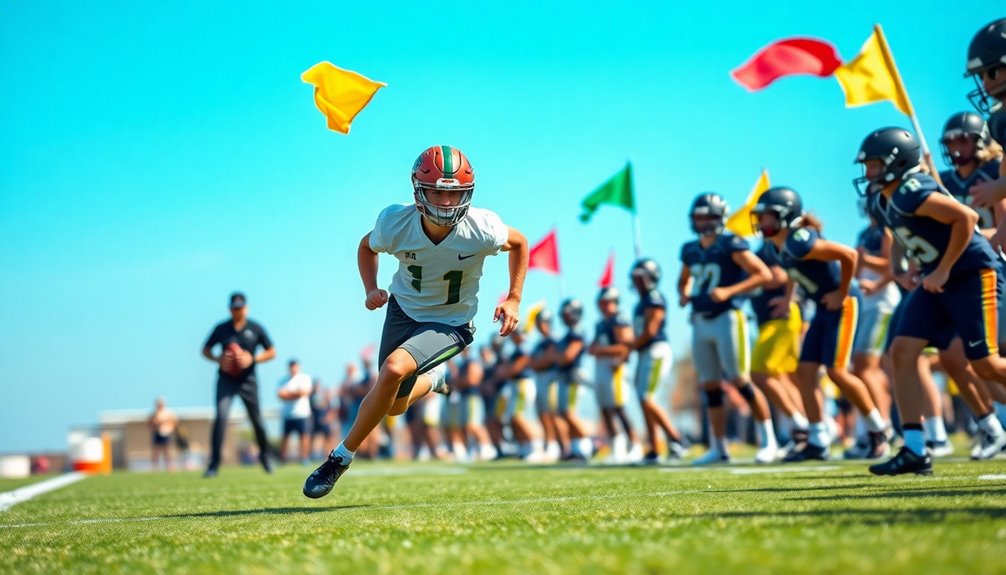
Mastering Flag Football Routes for Better Offense
January 13, 2025To master flag football routes and improve your offense, focus on key techniques and formations. Use specific routes like hitch, slant, and fly to create separation and stretch defenses. Understand each player's role within formations like Spread and Bunch to enhance your strategy. Timing and communication are crucial, so make sure your movements align with the quarterback's throws. Regular practice will refine your skills and foster teamwork. Adapting plays based on your opponents' tendencies can give you an edge. By honing these essential aspects, you can greatly elevate your game and contribute to your team's success. Discover more tips and benefits next!
Importance of Offensive Plays
Mastering offensive plays is vital for your team's success in flag football. These plays provide a structured approach that allows you and your teammates to execute your roles effectively. When you regularly practice these offensive plays, you foster teamwork and enhance communication, which are essential for minimizing collisions during route execution. Additionally, incorporating a dynamic warm-up routine ensures that players are physically prepared for the intensity of the game. Effective communication on the field can lead to better coordination and execution, similar to how communication with teammates is crucial in soccer for maintaining defensive shape and offensive fluidity.
To maximize your effectiveness on the field, develop a shortlist of preferred plays before games. This minimizes confusion and allows for quicker decisions between downs. Incorporating a variety of flag football routes, like slant and out routes, can help you exploit defensive weaknesses, ultimately improving the yardage you gain during plays.
Adaptability is another key factor. Different game formats, such as 5 on 5 or 7 on 7, require adjustments in your offensive strategy. By being adaptable, you can maximize offensive opportunities and guarantee inclusivity among players of varying skill levels. Additionally, practicing effective communication can significantly improve team coordination during plays.
Key Formations and Player Roles
- Receiver Roles: Different roles impact your offensive strategy.
- Formations: Utilizing formations can confuse defenses.
- Routes: Master various routes for effective plays.
In 5 on 5 flag football, you typically have one quarterback, one center, and three receivers. Each player has specific routes based on their positioning. Understanding player roles helps in optimizing your team's performance during games. The tactical adjustments made during gameplay can significantly enhance team success.
In contrast, 7 on 7 flag football features one lineman and four receivers—two slot receivers and two wide receivers. Slot receivers are closer to the quarterback and often run quicker routes, while wide receivers aim for deeper passes.
Common formations like the Spread Formation and Bunch Formation help create confusion for defenses by incorporating crossing routes and option routes. The successful execution of these formations requires effective communication among players to ensure everyone understands their role and positioning on the field.
Essential Offensive Routes

Effective offensive routes are the backbone of a successful flag football strategy. By mastering key routes, you can enhance your team's ability to create passing lanes and capitalize on scoring opportunities.
Start with the Hitch Route, where you run 7 yards forward and pivot back toward the quarterback. This creates a quick option for receptions, similar to the way midfielders connect defense and offense in soccer.
The Slant Route is another great choice; after a few yards, you cut at a 45-degree angle, allowing for fast receptions and extra yardage after the catch.
The Out Route is executed by advancing 5 yards followed by a sharp 90-degree cut towards the sideline. This route provides a clear passing lane for the quarterback.
For a more aggressive attack, use the Post Route. After a 7-yard run, cut towards the center of the field, gaining valuable yardage while evading defenders.
Lastly, the Fly Route involves a straight, deep run aimed at maximizing yardage. This route stretches defenses and opens up scoring opportunities. Understanding the offside rule can further improve your offensive strategies by ensuring you stay onside during plays.
Techniques for Route Execution
To execute your routes effectively, timing and communication with your quarterback are key. Each route type demands specific techniques and angles, so mastering these variations is essential for creating separation from defenders. Incorporating agility drills into your training routine can improve your footwork and speed, helping you run routes smoothly during the game. Additionally, consistent effort in honing your route-running techniques can significantly enhance your overall offensive performance. Moreover, engaging in Pain Shuttles Drill can boost your cardiovascular endurance, enabling you to maintain high intensity throughout the game.
Timing and Communication
Mastering timing and communication is vital for executing flag football routes successfully. When players are in sync, they enhance their performance on the field, leading to better offensive plays. Here are key elements to focus on:
- Timing: Confirm your movements align with the quarterback's throws.
- Communication: Use verbal and non-verbal signals to relay adjustments.
- Cohesion: Practice together to build team synergy.
Effective communication among players lays the groundwork for understanding timing and positioning during plays. This is especially important during crossing routes, where precise timing prevents collisions.
Regular practice helps you develop a natural rhythm with the quarterback, allowing for quicker decision-making in games. Incorporating both verbal and non-verbal signals during gameplay enhances your communication, enabling you to adjust your routes based on defensive shifts.
Consistent practice fosters team cohesion, confirming all players are synchronized and aware of each other's roles. By honing these skills, you'll boost your route execution and contribute greatly to your team's offensive success.
Route Variations and Techniques
Understanding the nuances of different flag football routes is necessary for any receiver looking to gain an edge on the field. To master route variations like the Out Route and Slant Route, you need precise footwork. Each route requires specific cuts and angles that help you create ideal separation from defenders.
Timing plays an important role, so aim to make your cuts at the correct yardage markers, ensuring you open up passing lanes for your quarterback. Effective communication with teammates enhances route execution. When running option routes, signal your intentions clearly to avoid confusion and create cohesive plays.
Incorporating head and shoulder fakes into your technique can mislead defenders, giving you a significant advantage as you make your breaks. Repeated practice of these routes in various formations helps develop muscle memory, allowing you to execute complex plays under pressure.
As the defensive line readjusts, your ability to adapt quickly will be essential. Focus on honing these techniques to elevate your game and improve your overall performance on the field. With dedication, you'll become a more effective receiver, making a notable impact on your team's offense.
Adaptability in Gameplay

In flag football, being adaptable is key to outsmarting your opponents. You can make versatile play adjustments and strategically position players to respond to dynamic game scenarios. Additionally, incorporating agility training into your practice can enhance your team's ability to make quick and effective route changes during the game. Core strength exercises can also support your players in maintaining balance and stability while executing these route changes. Furthermore, a strong aerobic base is vital for sustaining energy levels throughout the game, allowing players to stay agile and responsive under pressure.
Versatile Play Adjustments
Adapting to defensive formations is essential for success in flag football, and versatile play adjustments make all the difference. By honing your ability to adjust on the fly, you can exploit defensive weaknesses and create more opportunities for your team.
Here are key aspects to reflect on:
- Use a mix of formations, like Spread and Trips, to confuse defenders.
- Practice different route combinations, such as slants shifting into flies.
- Incorporate option routes for real-time adjustments based on field conditions.
When you master versatile play adjustments, you enhance your offensive strategies considerably. Effective communication among teammates is crucial during these adjustments, as it minimizes confusion and maximizes performance.
As you adapt to various defensive formations, focus on player positioning to open up passing lanes for your quarterback.
Strategic Player Positioning
Effective player positioning is essential for gaining an edge in flag football. Understanding formations like the Spread and Bunch allows you to strategically position yourself, creating mismatches against defenders and enhancing your offensive plays. Each player's role within these formations is important; for instance, slot receivers can run quick option routes while wide receivers execute deep routes, maximizing the effectiveness of your team's strategy.
Adaptability in gameplay means adjusting your positioning based on defensive setups. By recognizing weaknesses in the defense, you can create open passing lanes and capitalize on opportunities. Employing a variety of formations, such as Trips and Twins Stack, can confuse the defense and provide multiple options for the quarterback, increasing the chances of successful plays.
Regular practice of these formations fosters communication and teamwork, fundamental for executing complex routes effectively.
In NFL FLAG Football, a well-coordinated team that understands strategic player positioning will consistently exploit mismatches, making it difficult for the opposing defense to anticipate your next move. Embrace this adaptability in gameplay to elevate your team's performance and dominate on the field.
Dynamic Game Scenarios
Dynamic game scenarios demand quick thinking and the ability to pivot your strategy instantly. To excel in these situations, you've got to harness your team's adaptability and exploit every opportunity presented by the defense. Here are some key strategies:
- Practice diverse offensive plays tailored to player strengths.
- Implement combination plays that utilize misdirection to confuse defenders.
- Analyze game performance regularly to identify opponent tendencies.
In 7-on-7 flag football, the flexibility of player formations allows you to adjust your offensive plays on-the-fly. When you notice a gap in the defensive setups, don't hesitate to modify your approach for better execution.
By employing combination plays, you can create scoring opportunities while keeping the defense guessing.
Always assess your opponents' tendencies during the game; this analysis will sharpen your responsiveness, enabling you to make critical decisions that can turn the tide.
Adaptability isn't just about reacting; it's about anticipating and outmaneuvering your rivals in dynamic scenarios.
With practice, you'll find that quick adjustments lead to enhanced game performance and, ultimately, more successful plays on the field.
Preparation for Game Success
In flag football, preparation is key to achieving game success. Regular practice of offensive routes builds essential timing and communication among players, ensuring effective execution during games.
By analyzing defensive setups before the game, you can identify weaknesses to exploit through strategic route assignments. This preparation helps your team stay ahead of the competition.
Creating a shortlist of preferred plays based on your practice sessions facilitates quicker decision-making and minimizes on-field confusion. When each player understands their specific roles during plays, it maximizes the potential for successful offensive execution.
You'll find that clarity in responsibilities boosts confidence and efficiency on the field.
Incorporating a variety of offensive routes, like slants and outs, adds unpredictability to your game. This unpredictability makes it harder for defenses to anticipate your plays, giving your team a tactical advantage.
Remember, the more diverse your routes, the more challenging it's for opponents to react effectively.
Ultimately, thorough preparation not only enhances your team's performance but also fosters a cohesive unit that thrives under pressure. Additionally, a strong team dynamic can significantly elevate both motivation and performance throughout the season.
Conclusion
Mastering flag football routes isn't just important—it's the secret sauce that'll turn your team into an unstoppable offensive juggernaut! With the right formations and killer routes, you'll be dodging defenders like a magician and racking up touchdowns faster than the speed of light. So gear up, adapt your strategies, and prepare like a champion. When you nail your routes, you're not just playing a game; you're rewriting the very laws of flag football physics!


